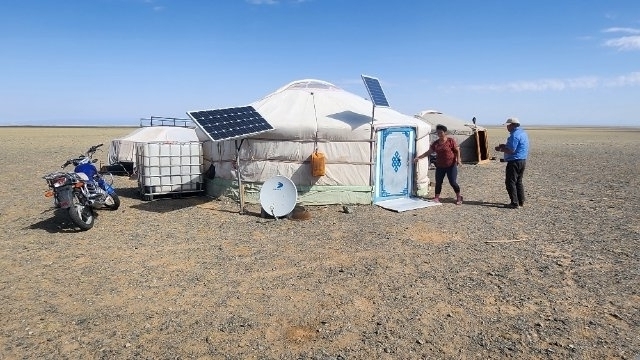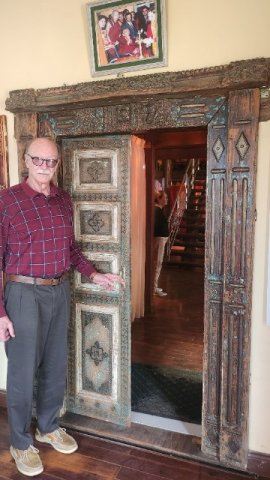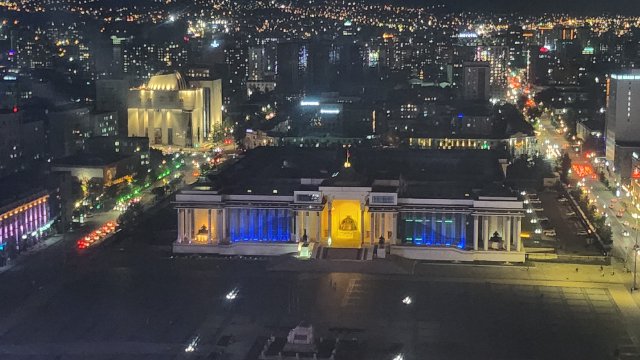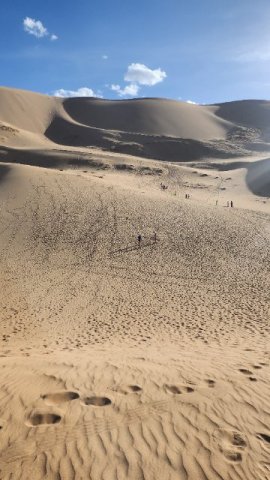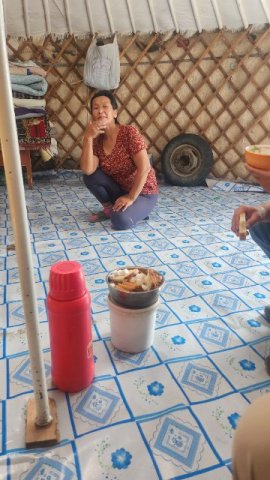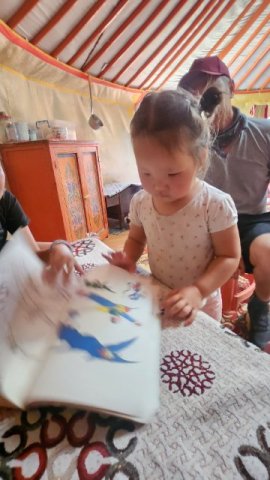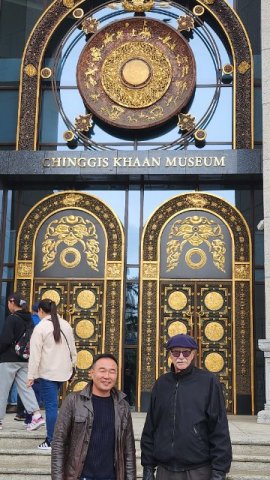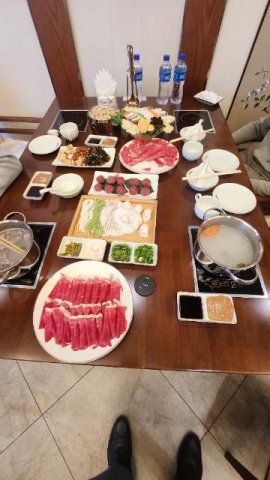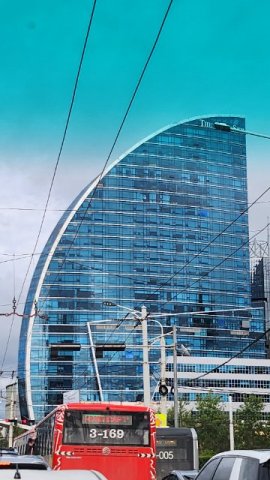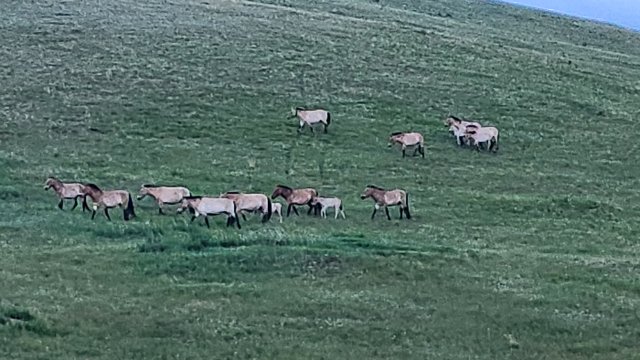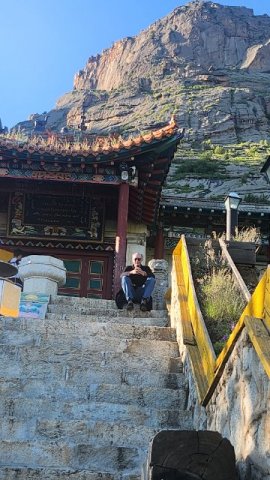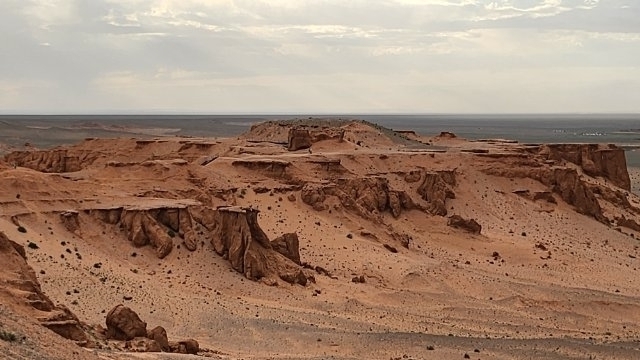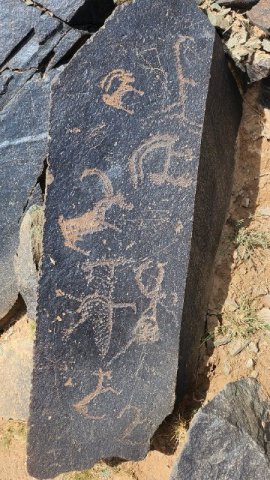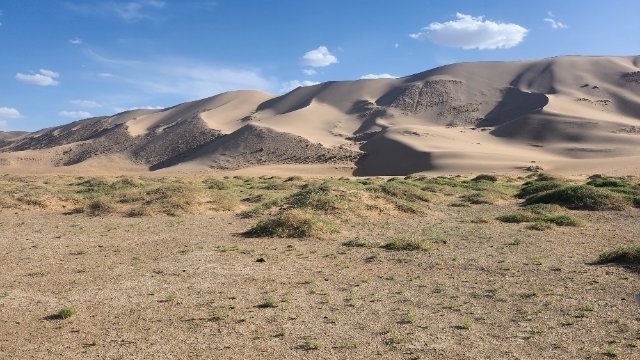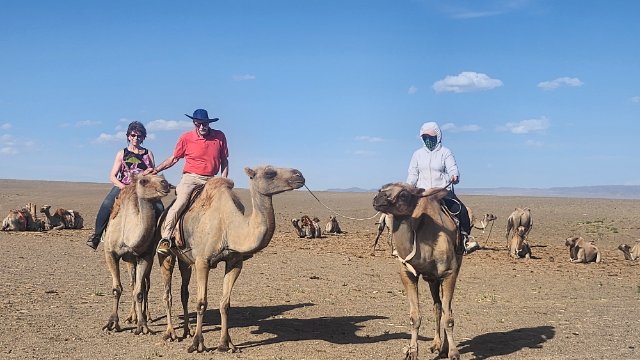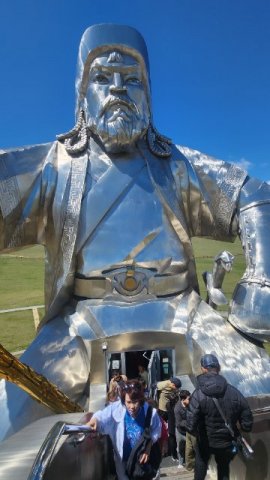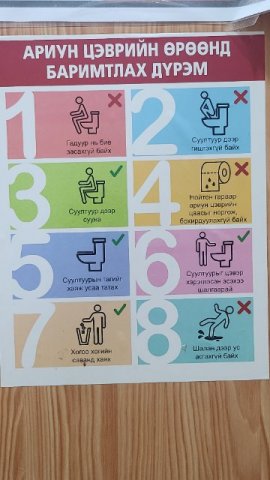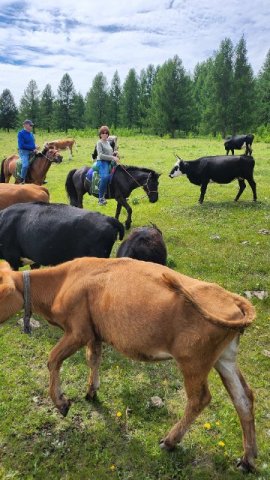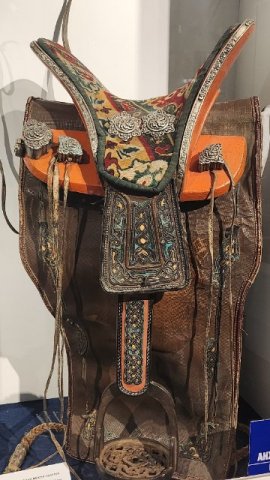Mongolia Travelog
Distant, Exotic, and Exciting
By: Victor Cordell - Jul 07, 2024
THIS TRAVELER’S NOTE IS DIVIDED INTO SECTIONS, MANY OF WHICH GIVE CONTEXT BUT MAY NOT BE OF INTEREST TO SPECIFIC READERS, SO FEEL FREE TO SELECT OR IGNORE. NOTE THAT I LACKED SPECIAL KNOWLEDGE OF MONGOLIA PRIOR TO THE TRIP, SO THIS 5,000 WORD CHRONICLE GREATLY REFLECTS LEARNING FROM NINE DAYS ON THE GROUND, ESPECIALLY FROM OUR WONDERFUL GUIDE GALSANBAT. MY WIFE, KARIN, AND I TOTALLY ENJOYED OUR TRIP AND RECOMMEND IT TO FELLOW TRAVELERS WHO SEEK A NEW AND DIFFERENT ADVENTURE.
GOING TO MONGOLIA
ARRIVAL - Summer Solstice 2024. My wife, Karin, and I departed from Seoul’s 94 degree steam bath on MIAT Mongolian Airline, with fully international service on my favorite aircraft, a Boeing 787 Dreamliner. As if boasting its position as the coldest capital in the world, arrival in Ulaanbaatar registers a bone-chilling 32 degrees and snow on June 21! Happily, the aberration was rectified by day 3, and seasonal weather, including a day of oppressive heat, carried the remaining 7 days.
WHY? - Many friends had questioned with trepidation – “Why are you going to Mongolia?” To begin with, we’re running out of new, interesting options. Importantly, it’s considered a destination for the adventurous, and that is true to an extent, but it has much to offer for its historic significance, distinctive way of life, and ecological interest. And with the right arrangements, luxury, not discomfort, awaits. Our sleepovers at the superbly-appointed Terelj Hotel and TS Khaan Resort have pocketbook-punishing rack rates if booked independently.
SEOUL MATES – Mongolia has a less developed tourism trade than many other Asian countries. The most visible tourist segment in Mongolia is young South Koreans. The countries share identity baggage. Koreans are often asked whether they speak Chinese or Japanese, although they take pride in their own distinctive written and spoken language. Mongolians are often asked if they are part of China or Russia, while they are fiercely independent. They both resent that much of their accomplishment is appropriated by their bigger neighbors. Many Mongolians have worked in Korea, with the result that the dominant restaurant cuisine in Mongolia is Korean. A final connection is that a common birthmark in the country of its name is the Mongolian blue spot, which usually disappears by age 5. Of other countries, Korea has the highest incidence of this condition.
OTHER VISITORS - In addition to Koreans, other visible intrepid travelers tend to be older ones who have a wealth of international experience, notably American and German. Tour operators like Gate 1 and Road Scholar offer group tours here with 15-20 guests.
GENERAL CHARACTERISTICS
PEOPLE COUNTS - Although Mongolia possesses a wealthy class, it is a poor country overall, though always self-sustaining. It has probably the most profound horse culture in the world. Half of its 3 million inhabitants live in the capital Ulaanbaatar. Over 60% of the rest are nomads, where the first yearning for possession is to own a horse, and there are many times more horses than people in the country. Perhaps another 3 million ethnic Mongols live in the Inner Mongolia Autonomous Region of China
LOOK - Appearances vary, with most having a characteristic Northeast Asian look with Central Asian influence – round face, high cheekbones, strong jaws, and narrow, almond-shaped eyes. Their lifestyle is hardy and athletic with interests like wrestling, archery, and horse racing. But despite their physical prowess, they are surprisingly soft spoken and polite.
ACTIVITIES FOR LOCALS AND VISITORS – With such reverence for horses, it is no surprise that horse racing is a very popular pastime, and many competitions are for children. As a traditionally masculine-dominated and outdoor society, the three activities of horse racing, wrestling, and archery are celebrated in their most important festival, Naadam in July. Another festival of interest is the Eagle Festival in September, which is a tradition of the Kazak minority in western Mongolia. A unique, not to be repeated event occurred while we were in-country. The International Ultra Marathon took place in the Gobi, with over 100 contestants in a 225km race over five days. We had met participants at the airport and saw them on the course one day. What an unusual commitment they have!
COMMUNICATIONS – Internet was available at all of our stops, but in a couple of the accommodations it was only in the main lodge. Amazingly, cell phone service is ubiquitous, with drivers on the phone in the remote areas of the Gobi.
DIET - Their diet draws from their nomadic roots, dominated by straight-forward preparations of red meat – beef, lamb, goat, and horse - and dumplings, with relatively little food from plants. Philosophically, they believe that it is wrong to eat young animals, so that their meat is from older, tougher specimens. Chicken, pork, and seafood are for foreigners. Ironically given the high incidence of lactose intolerance in Asia, nomads turn to dairy-heavy products in the summer following the birthing season for their herds. Some influence from cuisines of nearby countries has yielded greater balance in the diet.
RELIGION - Mongolia may be considered a godless society (yay!). About half are Buddhists in the Tibetan Vajrayana tradition. In this minor division, all documents are written in Tibetan, leading to alienation of some from the tradition due to the lack of understanding Tibetan. For those less familiar, Buddhism is a moral philosophy with Buddha being considered a teacher rather than a god, which is why it is a godless religion. Another 40% are without religion, meaning for most that they believe in some form of shamanism with local rituals and beliefs concerning the relationship of sentient beings to the spirit world.
LANGUAGE – Mongolian is unrelated to other East Asian languages, sharing its roots with but quite different from Turkish. Its written form was traditionally a Uighur based script read from top to bottom, but until the 20th century, 99% were illiterate. However, because of Russian influence, Mongolia adopted Cyrillic script in 1941 with an alphabet little different from Russia’s. Literacy has soared.
ANIMALS – Over 70 million domestic livestock are husbanded mostly by nomads. They live in collapsible, moveable gers (pronounced gair, also known by their Turkic name, yurt), which dot the countryside. They are herders who move up to 200 kilometers with the seasons to find nutrition for their stock. Probably 75% are sheep and goats, raised primarily for wool and cashmere respectively. The other key domestic animals are cattle (for dairy), horses (sporting and as liquid assets when short of cash!), and camels (transport and tourism). All are also used ultimately for their meat.
LAND – This land of contrasts and contradictions is about twice the size of Texas and has three ecological zones of interest to tourists. The center is treeless with soft green hills, much like the coastal range of California, but without even the riparians that we have in the crease valleys between hills. Only 6% of the land is forested, and that is in the north. The south is the vast fearsome Gobi Desert with endless vistas of flat hardpan and sparse vegetation. Mongolia is a significant producer of coal and mines a number of metals as well.
LOCATION AND CLIMATE - While its latitude is similar to Vancouver or Paris and its altitude is a bit lower than Denver, the continental weather is brutal and plays a major role in life, with summer highs over 100° F and winter lows of -40° F. Herds find nutrition by moving around the area. Yet, when livestock die, it is usually from winter starvation rather than exposure. Horses are less susceptible to winter kill as they can use their hooves to dig through snow to find food, which cattle and others can’t.
POLITICAL HISTORY
GLORY YEARS - Remarkably, the Mongol Kingdom first under Genghis Khan (American spelling – local spelling will be used for sites), and later under his grandson Kublai Khan in the 13th century became the largest the world has ever known, stretching from the Pacific to the Mediterranean. It boggles the mind that they could manage such an empire, but with rapid transportation/communication and using the example of total destruction of communities that failed to kowtow, they ruled. Philosophically, Genghis felt that there was only one king under the stars, and that he was merely enforcing his divine right. Detractors felt that he was cruel and vile. Your thoughts?
LOSS OF DOMINION - The geographical growth of the United States has been monodirectional, growing from “sea to shining sea” with nary a setback or giveback. Conversely, East Asian history is exceedingly complex, with the rise and fall of Mongols, Manchus, Hans, and more. Borders of empires and countries have been fluid. Ethnicities overlapped and hegemony has occurred in various guises. Over time, Mongolia has been subjugated by China and Russia, and Inner Mongolia has been absorbed by the former, but it is still a people proud of its accomplishments and resentful when they are appropriated by their larger neighbors and others. In current culture, for instance, the Disney character Mulan is based on Mongolian history, not the derivative Chinese legend.
VASSAL STATE - The country’s modern history is a lesson in nuanced influence in international relations. Although Mongolia was never part of the USSR, the Soviet Union championed Mongolia’s becoming a UN member as an independent country in 1961. The former dictated the latter’s political policies for all but the first and last decades of the 20th century. The reason is that at great loss of life, Russia defended Mongolia from assaults by China, and it thus established dominion. Later, the imposition of communism, Stalinist purges, and the obliteration of Buddhism reflected the USSR’s determination to dictate the political life of its ally despite lacking any formal relationship. Russia can be also credited with bringing ballet, symphony, and opera to the country. With the collapse of the Soviet Union in 1989, Mongolia adopted democracy which it still retains.
A DELICATE DANCE - Present-day Mongolia is landlocked and borders only superpowers China and Russia, needing to appease both without overtipping in one direction. Mongolia relies on China for airspace and third country trade facilitation, while it relies on Russia for all of its energy needs. And with massive potential for wind and solar power, it can only dabble in those areas for fear of alienating Russia. The good news is that both superpowers want Mongolia to remain a buffer, giving it a bit of an ace up the sleeve.
IF ONLY! - Small distances have profound effect on international politics. Witness the influence on history of the 25 miles that separates Britain from the European continent, or the neck of North Korea along the Sea of Japan that keeps China from the open sea there and gives the smaller country a border with Russia as well as China. In the case of Mongolia, it is separated by a mere 15 miles from Kazakstan. Imagine the difference if the former had access to a third country.
ULAANBAATAR
THE CENTER - Another Russian influence is that the modern name of the capital means Red Hero, a very communist theme. Much like many large cities in middle-income countries, Ulaanbaatar has miles of non-descript mid-rise buildings. The heart of the city is Sukhbaatar Square which is surrounded by some pleasant looking classical public buildings, some in bright colors like red or blue. The only building on the square is the Parliament Building. Ingeniously, the brutalist communist era building received a glass facade and flanking columns to create a more pleasing look that the country can call its own.
KEY SITES - The main museums are all nearby and very walkable. The National History and Natural History museums both contain interesting and informative collections, but English language signage can be limited or missing, and the overall maintenance is not great. The Choijin Lama Temple is a cluster of pagodas that depict Buddhism’s representation in the country. A 13th century complex is an hour outside the city, but we didn’t visit it. Equidistanced from UB is the Chinggis Khaan (Mongolian spelling) statue complex, well worth the visit. The stainless steel statue is the largest equestrian statue in the world. It rises to 130 feet tall. You can stand atop the horse’s neck and view the khaan’s face up close and personal. By comparison, the presidents’ heads at Mount Rushmore are 60 feet high, and Crazy Horse’s at his memorial is 87 feet.
THE BEST - One museum is king, and that is the Chinggis Khaan Museum. Of course, that’s a play on words as khaan means king. Telling the story of the era surrounding his reign, this nine-story dedication to his life and times is full of attractively-presented subtly-lit collections, striking free-standing statuary, and well-designed dioramas. Perhaps we all grow up ethnocentricly, and are surprised to see some of heritage as being ersatz. I have always clung to unique notions about the American West of the Pony Express, branding irons, and chipped arrowheads. Their predecessors are on display here from six centuries earlier, with no claim that there weren’t antecedents. This museum is definitely world class.
MEMORABILIA - At this point, we have to manufacture display space in our home anytime we purchase artifacts, but we’re still interested in looking and maybe buying selectively. There is a small area of antiques stores in UB, but it is much more limited than in many other destinations. And despite the low level of tourism, the prices quoted to foreigners tend to be pretty obscene. You’d have to be a serious buyer to get items that you hope are actually antiques, but older looking new artifacts are reasonable – religious items like temple hand bells and lightning bolts or horse and dress paraphernalia are good picks. Shiny new knick-knacks are available and mostly tacky.
CUISINE - As noted before, the local cuisine is very limited. One specialty to enjoy however is hot pot, which uses finely sliced meat (we had beef and horse) that tames the toughness and many veggies. We went to The Bull, a distinguished eating establishment and enjoyed a top flight Mongolian hot pot. Because of the emphasis on meat, one specialty item that is widely available is bone marrow.
RESTAURANTS - Fortunately, restaurants are abundant and varied, but not necessarily authentic or top quality, though all of the following can be recommended within context. Near the square, Singaporean Food has decent Southeast Asian food; Hazara hadsbetter Indian food; and Silk Road is pretty good with its cosmopolitan menu. We had Korean, including table-cooked barbeque and Korean fried chicken, at a destination restaurant, Seoul Restaurant, which is well worth the trip. Our hotel, Blue Sky, has several restaurants. In a post-pandemic funk, the only ones open were the Korean, which closed early, and the 23rd Floor Lounge, which stays open until 2AM, but the food is brash and not satisfying to a persnickety foodie.
FRANCHISES - Fast food and caffeine chains are pretty rare. KFC is most visible, with a little representation by its sister Pizza Hut and by Burger King. McDonalds and Starbucks are conspicuously absent, as are all others in the category
PROVISIONING - The grocery store scene is much different. We were impressed with the scope, quality, and reasonable prices of foods from many countries. Better supermarkets are associated with better department stores. They carry basic offerings like Del Monte canned fruits and select items like fine unsalted French butter. Three local food ingredients are of note – very good honeys, affordable pine nuts, and a nice fruit that is juiced – sea-buckthorn, which is like a currant but with apricotish color and taste. Because of its thorny host plant, it is harvested after freezing by shaking the bush to release the fruit. Chocolate is very popular – from locally-made to Godiva, with Russian brands being dominant. Individually wrapped bags of candy receive inordinate shelf space, suggesting a national sweet tooth.
FINEST OFFERING - The most distinguished product is fine cashmere, which is not cheap, but better priced than in the States. Designs are very attractive. Mongolia is second to China in cashmere production, but the latter has 400 times the human population. Apart from huge standalone specialty stores, what was eyepopping was to see about 20 branded cashmere boutiques on one floor in a department store.
PRIUS PARADISE - Some years back, I referred to the Bay Area as ground zero for Priuses. Boy, was I wrong. Prius probably has a 50% market share here, but with a couple of oddities. Along with other cars, almost all are purchased used from Japan as an economy saving measure. But the roads in Mongolia are laid out for left-hand drive cars, and cars in Japan are right-hand drive, so most drivers here are in the wrong position. Oddly, Prius is the car of choice for its fuel economy, yet UB seems to have a superabundance of gas stations on its outskirts. One thing that may dampen fuel economy is that the traffic is always awful except in the wee hours.
CULTURAL FOLKLORE SHOW - Having attended these in any number of Asian countries, we attended more by obligation and because it was included in our tour. Happily, it was the best I ever remember seeing. Acts were brief, brisk, and varied. Performances were great, and costumes were appealing. Many had equine themes of some sort, especially dance numbers which use much simulated horse movement and sound.
Most distinctive, however, were two forms of vocalization. First was a man throat singing, which is a unique practice in which the singer produces two-tones simultaneously. This astounding singer was able to sustain low tones while creating a melody in high tones. Another act involved two women vocalizing an eerie duet that is somewhat reminiscent of Chinese opera but very compelling.
In the final act, two young women demonstrated extreme contortionism combined with strength and athleticism. While one was contorted and balanced upside-down on the other, she used her feet to draw a bow and shoot an arrow into a target. Totally unhuman!
LODGING – We stayed at the Blue Sky which is noted for its cobalt blue glass skin and a shape like a sail. It postures as a 5-star hotel, but it is really a tourist level hotel with a few extras, like really nice bathrooms. But the furnishings are like in an old Soviet Intourist hotel. The breakfast buffet however is very good except for anemic coffee. Across Peace Avenue from Sukhbaatar Square, no hotel is better located for being able to walk to virtually all of the tourist attractions in the city. The sexiest lodging in town is definitely the Shangri-la at twice the price. Otherwise there are the Novotel, Kempinski, Holiday Inn, Best Western, Ramada, or a number of local hotels without international management companies.
OUR TOUR
We took a nine-day tour at the end of June, 2024, booking through Mongolian Luxury Tours, a local tour operator. We have heard about problems with using overseas tour agencies, but MLT seemed quite established and reputable. They lived up to every single commitment including airport transfers; an unbelievably superior guide, Galsa, who was with us the full time, including the portion we flew to; drivers for each region whose internal GPS was unerring; fees and costs for all of the entries and events bar known exceptions (animal rides and alcoholic beverages, both of which are cheap anyway); and restaurant selections in UB from among the best. My only complaint was that sometimes during the pre-trip arrangements, repeated nudging was required to get a response, but it is still highly recommended. Be aware that tours to Mongolia are not cheap, nor is the air fare, but it is a very special destination.
We were told that six clients had signed on, but the other four who had paid opted to defer until next year. There had been news in the US about with winter kill of several million livestock due to particularly severe weather, and perhaps there was fear of the consequences from that. We saw a total of two animal carcasses and a few piles of bones, but nothing that seemed out of the ordinary.
Since we were the only clients and purchased the package at an extremely attractive rate, we felt badly, as MLT must have taken a loss on us. But they still delivered the goods without complaint. At times, we felt that it might be nice to meet some new friends and share the experience, but overall, we were totally spoiled and appreciated the special service and having the guide in our vehicle full time, as a lot of time is spent on the road. We were always able to make changes to the itinerary without approval from others; go through museums at our own speed and focus on our own interests; and the attention we received from our guide was phenomenal.
Note that the standard is to tour in 4-wheel drives, and if there were six pax, we would have been with the guide 1/3 of the drive time. Outside of UB, the average drive time to sites of interest was probably 1 ½ hours each way, and for one, the Dunes, it was over 3 hours each way. Be aware that much time is spent on dirt/gravel roads, and they can be washboard or rutty. Most travelers will have no problem with this, but for those who are particularly vulnerable to motion sickness, it may not be a great choice.
VISITING A NOMADIC GER
Nomadic life can be severe, with temperatures in most of the country averaging 0° F high and -30° F low in January. In the Gobi, summer high temperatures are usually in the 80°s F but can exceed 100° F. Yet life goes on in circular gers of leather or cloth with felt insulation that nomads produce and a hole in the roof to vent smoke from cooking and heating from dung. Decor is limited and tatty. At the one we visited, several medals were on display, the only one that was explained was for having at least six children. Most nomads have some conveniences – a solar panel for electricity, a refrigerator, television, internet, and cell phone connection. For some, herding is not done by horse but by motorcycle.
Hospitality is de rigueur from the host, and acceptance is obligatory by the guest. If you can stomach the offerings with a smile, you’re a better person than I. Milk tea will always be offered, and it is uniformly insipid. Ours was from horse milk. But that was a pleasure compared to what came next – like a liquid yoghurt from camel’s milk that registered 11 on a sour scale that goes to 10. One sip and I was done. Top off the summer dairy diet with tooth-breaking dried, sweet yoghurt. The tasteless hard, wheat rolls were a welcomed relief.
HUSTAI
Less than two hours from UB, this national park is noted for its resurrection of the Takhi horse (known as the Przewalski in the west), which had gone extinct in the wild, but fortunately some zoos in the West retained live specimens. They are considered the prototypical Mongolian horse and the only confirmed wild horse extant – American mustangs, for instance, are feral domesticated horses. The Takhi were resettled back to their homeland in the 1990s and have thrived in this hospitable environment.
They are best found watering and feeding around dusk, and we were fortunate to see several groups of 5 to 20 horses each. Unlike a mixed-trait herd, the Takhi are well defined. They are heavy headed, short, sturdy steeds, and their colors are constant among all specimens – graduated biscuit with burnt toast features. This being the season, there were numerous fawn-colored colts as well. In all, setting and horses were beautiful.
We also saw numerous marmots, which are a popular specialty meat, and occasional vultures. If you have time and go deeper into the park, aspen birch forests are home to many species including boars, foxes, and wolves as well as hugely varied flora with up to 30 species of mushrooms alone.
LODGING – Common to Mongolia, the primo resorts are far from the tourist destinations, but well worth it if you care to pay the freight. While you can stay right outside the park in spartan digs, we lapped up luxury 1 ¼ hours away at HS Khaan Resort. They offer Mongolian chic, with widely-spaced gers of an amazing 1,200 square feet, having picture windows overlooking a beautiful valley. Furnishings in the stepdown living area, dining, dressing room and wet bar are Mongolian modern, while the sleeping nook is traditional. Bathrooms are top flight as are toiletries. Dinner is six courses plus, and even breakfast is served in several generous tranches. The establishment’s drivers convey guests from lodging to reception and restaurant. All in all, a great experience.
TERELJ
This national park lacks anything of historic significance. There is Turtle Rock, which you look at and pass on, and a Meditation Temple. It requires a bit of an uphill hike, and the voyage may be more interesting than the destination, which is a humble Buddhist temple. Wildflowers are profuse and beautiful. The park is also a place for horseback riding and holding eagles and vultures on a protected arm like a falconer. We enjoyed doing both, and despite the wealth staying at the adjacent hotel, the riding cost $6 per hour.
But Terelj is in the forest, and UB residents come here even in the dead of winter with -30 degree temperatures just to see the greenery and breathe the fresh air. Energy in UB is coal powered, and being in a valley, air pollution is trapped over the city, especially in the winter.
LODGING – We stayed at the Terelj Hotel, a recurring award winner, where the superwealthy stay. Different from any other place we stayed in Mongolia, this hotel is luxurious in the western sense. Unlike Mongolian chic, which can be very uneven in materials and design, this place is as harmonious as you would expect from a Ritz Carlton. The food is also top flight. One oddity is that, like some other places in Mongolia, the dining prices are on a much lower plane than the lodging prices.
GOBI DESERT
ECOLOGY - The most famous and unique landscape of Mongolia is the Gobi Desert, a vast semi-arid land. Though mountains and dunes exist, the overwhelmingly feature is vast miles of flat, treeless, bushless, hard-pan covered with rock shard. Herds forage for clump grass and other plants only several inches high. Occasional rain produces a carpet of greenery, and herders hope to take advantage as rain occurs. As noted elsewhere, climate can be extreme, especially the cold of winter, and appreciable winds are near constant.
DRIVING THE GOBI - With a network of miles of unpaved, unmarked driving trails, it is truly a miracle that drivers can find their way. The often washboard dirt tracks intersect, run parallel, and veer from one another. They can typically be driven at an average of 50 mph, with occasional slow-downs, but only a professional is capable of finding the way around.
BAYAN ZAG (FLAMING CLIFFS) – Because of overcast, we couldn’t enjoy the redness of the rock at its most brilliant, but we did appreciate the area for its beauty and significance. For a decade starting 1922 American paleontologist Roy Chapman Andrews led digs in the area that found for the first time anywhere that dinosaurs lay eggs. They also identified several new species of dinosaurs; catalogued thousands of animals and plants; and mapped areas previously dark spots to cartographers. A terrific film from the expeditions testifies to many of their accomplishments.
YOL (VULTURE) VALLEY – This area is full of rugged, jagged mountains. We rode horses into the gorge, seeing gerbils, ground squirrels, and a single ibex high on a ridge. We rode beside glaciers that have the compressed blue ice, but it looks probable that the permanent ice will melt this year given climate change. A small but informative natural history museum has stuffed animals from the region.
KHONGORYN ELS (KHONGOR SAND DUNES) – These golden dunes run 70 kilometers but only hundreds of meters wide along the Altai Mountains, so they are significant examples of their kind with huge peaks and ridges. The shifting of the sand from the winds create the sound of “Singing Sands.” At our point of contact we rode camels to arrive at the dunes, but as we were led along by a guide rather than riding freely (which we have done on camels before), it didn’t offer much stimulation. At the dunes, sliding on plastic disks is popular, but most people go about half way up the dunes where the slope is not steep enough to allow sliding. For those who take the more arduous climb to the top, the reward is a steeper decline which does allow sliding higher on the dunes.
KHAVTSGAIT PETROGLYPHS – These rocks have an abundance of visual representations from the Bronze Age (4000 to 3000 BC) on the steep, slippery escarpments of a sacred mountain. Carved and painted motifs consist of scenes and effects from everyday life of a time long ago, with pictures of people, animals, implements, and more.
LODGING – GOBI NOMAD LODGE – This is the primo place to stay in the Gobi, and we were there for two nights. You stay in a luxury, climate-controlled ger with an ensuite safari-posh bathroom in flagstone and marble with Occitane toiletries. The food is good but not exceptional, but the overall experience is very nice.
LODGING – GOBI ERDENE LODGE – This was the only disappointment of the trip. Digs are spartan log cabins with minimally functional bathrooms. There is neither fan nor air conditioning, and we had 95 degree heat. The locations of the tiny windows made it difficult to get ventilation, and the one night there was pretty miserable. This was the lodge for the Dunes, and my suggestion is that if it is hot and you have the option to gird your loins and drive 3 hours each way to the Dunes on the same day or to skip them altogetherMISSED OPPORTUNITY – The Gobi was the only area that we needed a domestic flight to access. Some tours include Khuvskul Lake, which is also a flight away in the northwest corner of the country. It is supposed to be one of the deepest and five cleanest lakes in the world (sound familiar to what is said about Tahoe?).
CONCLUSION
Mongolia is a distant and exotic land that stimulates and excites. We’re very happy to have experienced it. While it can be expensive, opting for a small touring group is worth the money. It is possible to make arrangements on the fly once there, but it would be very complicated.

